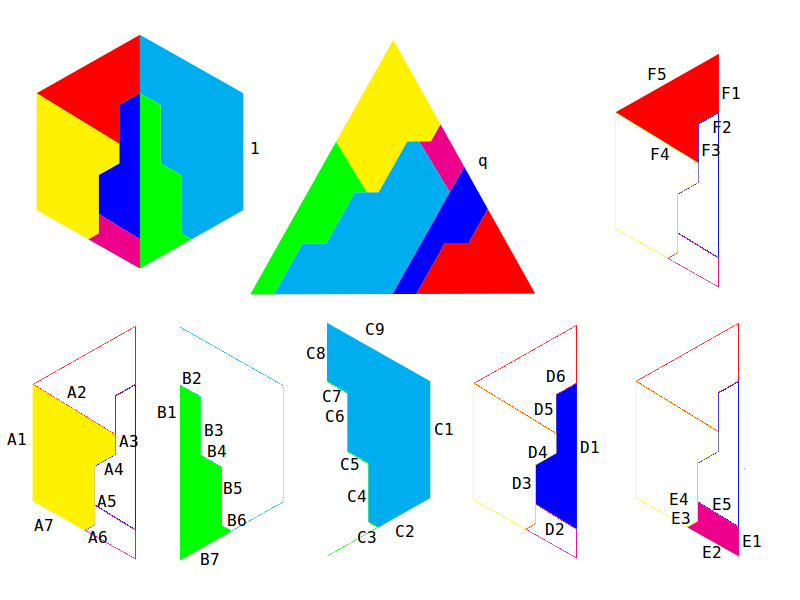Partial solution: I'm only trying to give upper and lower bounds of the solution.
First of all, let us notice, that
the area of the triangle and the area of the hexagon is obviously the same, so if the sidelength of the hexagon is $1$, then the sidelength of the triangle is $\sqrt{6}$.
With that it is easy to prove, that if such dissection exists it has to consist at least of
three tiles: The triangle contains three points - the three corners - which pairwise have a distance larger than $2$, which is the maximal distance of two points in the hexagon. So those three have to go in different tiles.
Let's go for an upper bound:
I might be totally wrong, but actually think this is a trick question, at least the tileset given in the question seems to be one of those which don't actually fit each other or the given larger shapes - like how 8x8 squares can be rearranged into 5x13 in the well known trick puzzle.
I've built a system of linear equations, where the equations came from:
1) The length of edges are known for both the hexagon and the triangle. This gives $9$ equations in total.
2) The length of 'internal' edges can be expressed two different ways. That is, one equation for each of these edges.
3) Each tile has edges parallel with one of the sides of the great polygon, which means that projections onto lines which are perpendicular to the sides again can be expressed two different ways with the help of the edges, and the coefficients are all the same in absolute value, because $\cos(\frac\pi3)=-\cos(-\frac\pi3)$. This gives $2$ linearly independent equations per tile.
I used the following notation:
 ,
,
which gave the equations:
$A1=1$,
$F5=1$,
$C9=1$,
$C1=1$,
$C2+B7=1$,
$E2+A7=1$,
$A2=F4$,
$F2=D6$,
$A3+F3=D5$,
$A4=D4$,
$A5=D3+E4$,
$E3=A6$,
$D2=E5$,
$F1+E1+D1=2$,
$B1+C8=2$,
$C7=B2$,
$B3=C6$,
$B4=C5$,
$B5=C4$,
$B6=C3$,
$q=\sqrt{6}$,
$A2+E5+D2+F4=q$,
$F5+D6+C9+B2=q$,
$B1+A1=q$,
$B7=A7$,
$B3=C8$,
$B4=C7$,
$B5=C6$,
$B6+A6=C5$,
$A5=C4$,
$A4=C3+E3$,
$E4=A3$,
$E2=C2$,
$D1=C1+E1$,
$D3=F3$,
$D4=F2$,
$D5=F1$,
$A2=A4+A6+A7$,
$A1=A3+A4+A5+A6$,
$B2+B4+B6=B7$,
$B1=B3+B5+B7$,
$C9=C2+C3+C5+C7$,
$C1+C2=C4+C6+C8$,
$D2=D4+D6$,
$D1=D3+D4+D5+D6$,
$E2=E3+E5$,
$E1=E3+E4$,
$F5=F2+F4$,
$F1+F2+F3=F5$,
which does not have any solutions.
This means, that
we don't even have an upper bound of six for the answer. Furthermore, although I cannot yet prove it, I suspect there is no such tiling at all. But it can also happen, that I made some errors when transcribing the equations, and there is no trick at all.


